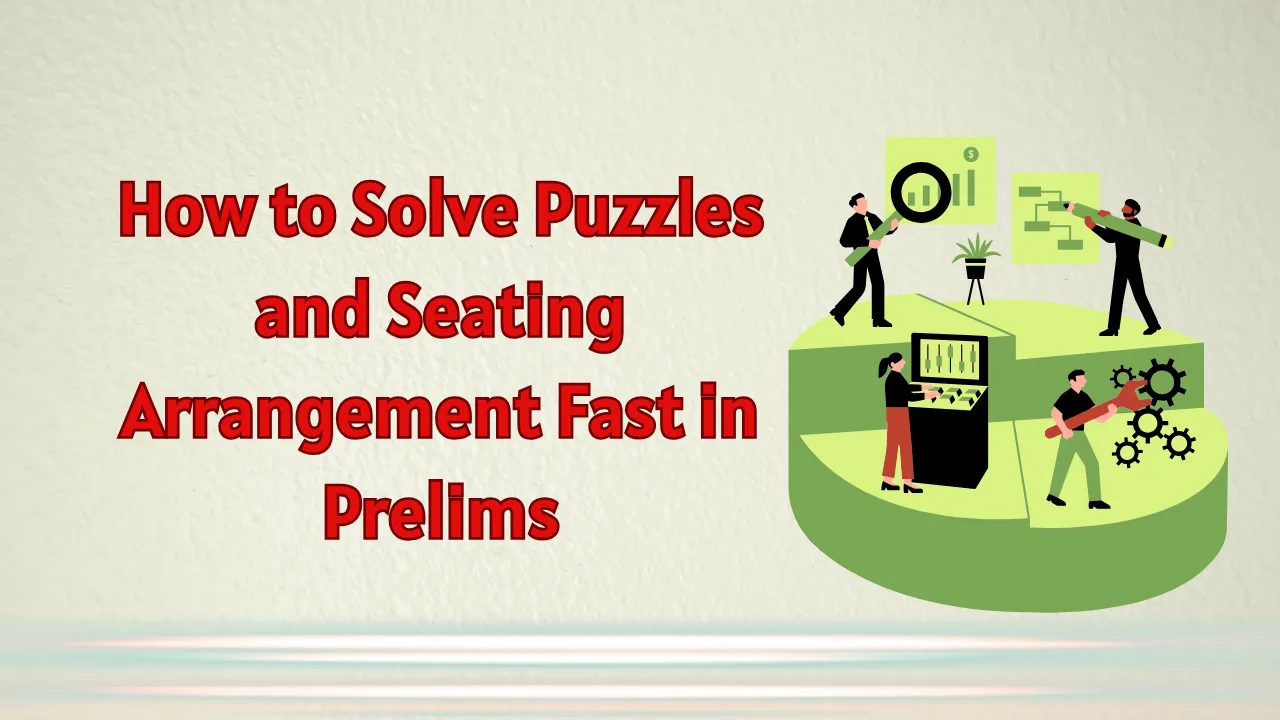How to Solve Puzzles and Seating Arrangement Fast in Prelims: How to solve puzzles and seating arrangement fast in prelims is a key question for every banking and government job aspirant. These topics form a major portion of the reasoning section and are often the most time-consuming if not approached smartly.
In this article, you’ll learn step-by-step strategies, solving techniques, and daily practice tips to crack puzzles and seating arrangements with speed and accuracy. Whether it’s linear, circular, or floor-based puzzles, this guide will help you build the right approach to handle them confidently in prelim exams like IBPS, SBI, and RBI.
Understand Puzzle Types in Prelims
Before you improve speed, know what to expect. The reasoning section typically includes 3–4 sets from these puzzle types:
- Linear Seating Arrangement – People sitting in a line, facing same or opposite directions
- Circular Seating Arrangement – People sitting around a circle, inward or outward facing
- Floor-Based Puzzle – Assigning persons to different floors in a building
- Box-Based Puzzle – Boxes stacked one above the other with conditions
- Month/Day-Based Puzzle – Assigning data to months/days with extra variables
Understand the structure of each type so that you can quickly identify and plan your approach in the exam.
Read the Entire Puzzle Carefully First
The biggest mistake students make is rushing into writing before reading everything. When solving puzzles:
- Read the whole question once without writing
- Identify the main subject (e.g., persons, seats, floors)
- Highlight key terms like “immediately,” “not,” “between,” and directions
- Understand relationships before drawing
This step saves time in corrections later and improves your first-attempt accuracy.
Use a Clear and Consistent Diagram
A neat diagram saves you from confusion and makes solving faster. Here’s how:
- For linear arrangements, draw boxes or arrows based on direction
- For circular puzzles, place positions using compass directions (top as North)
- For floor puzzles, list floors top to bottom as 7 to 1 or 10 to 1
Be consistent with symbols. Use “_” for unknowns, arrows for direction, and abbreviations for names. A clean diagram = faster thinking.
Start with Definite Information First
In puzzles, never guess. Use direct and confirmed clues first.
For example:
- “A sits second to the left of B” → Place A and B relative to each other
- “C lives on the top floor” → Fix C first
- “Only two persons sit between D and E” → Try all valid positions later if needed
Use clues that give fixed placements before conditional or vague ones. This builds the puzzle’s structure.
Two Smart Strategies for Speed
- Possibility Elimination Technique:
If one clue gives multiple positions, try all in parallel. Use pencil or draw two diagrams. Eliminate the one that leads to contradiction. - Block Solving:
Some clues give a group of elements (e.g., A sits between B and C). Treat them as a block and try to place that block instead of placing individuals.
These strategies prevent backtracking and increase your solving efficiency.
Practice with Time Limits
Practicing puzzles without a timer leads to slow improvement. Set a timer for:
- Easy puzzles – 3 to 5 minutes
- Moderate puzzles – 6 to 7 minutes
- Hard puzzles – 8 to 10 minutes
Daily time-bound practice will train your brain to think under pressure.
Keep a Puzzle Logbook
Maintain a notebook for daily puzzles. For each one, note:
- Puzzle type and level (Easy, Medium, Hard)
- Time taken and accuracy
- Mistakes or tricky clues you missed
Reviewing this once a week helps track your progress and identify weak areas.
Common Traps to Avoid
- Ignoring directions (left/right, inward/outward)
- Overwriting diagrams, leading to confusion
- Assuming facts not given
- Spending too long on one set—move on if stuck
Prelims exams are time-bound. Accuracy with smart time usage wins over solving everything.
Practice Sources to Master Puzzles
- Books:
- A Modern Approach to Verbal & Non-Verbal Reasoning by R.S. Aggarwal
- Puzzle Mania by Oliveboard (Online PDFs)
- A Modern Approach to Verbal & Non-Verbal Reasoning by R.S. Aggarwal
- Websites & Apps:
- Testbook, Gradeup, Adda247, Oliveboard for topic-wise puzzles
- YouTube channels like Study Smart or Adda247 Reasoning
- Testbook, Gradeup, Adda247, Oliveboard for topic-wise puzzles
FAQs
Q1. How many puzzles should I practice daily?
Start with 2–3 puzzles per day, gradually increasing to 5 with mixed difficulty.
Q2. Are puzzles more important than other reasoning topics?
Yes, they carry higher weightage in prelims, especially in bank exams.
Q3. How much time should I spend on one puzzle in the exam?
Ideally, not more than 6–8 minutes. If stuck, move on and come back later.
Q4. How do I handle puzzles with multiple variables?
Use tables or grids to align names, colors, floors, etc. Keep it organized.
Q5. Can I skip puzzles if I’m weak?
It’s risky. Puzzles carry bulk marks. Instead of skipping, focus on mastering at least 2 types.
Final Thought:
Learning how to solve puzzles and seating arrangement fast in prelims is a matter of regular practice, strategic thinking, and time management. Use diagrams smartly, follow fixed approaches, and track your performance. If this article helped you, share it with fellow aspirants and don’t forget to check out our posts on mock test strategies and reasoning shortcut tricks to boost your score.















